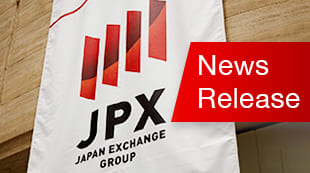Search results 4021-4030 / 10651
- sort:
- relevance
- latest

Price of CBs (Parity and Deviation rate) | Overview (CB) | Japan Exchange Group Price of CBs (Theoretical Price) Deviation Rate Convertible Bonds Price of CBs (Parity and Deviation rate) Risk Parity is the theoretical price of a CB. The parity of a CB can be derived by the following formula. Parity = (Share price / Conversion price) x 100 (yen) In other words, if the stock price is 1,200 yen and the conversion price is 1,000 yen, the parity is (1,200 yen / 1,000 yen) x 100 = 120 yen. However, the price of CBs is not always in line with parity, as it is affected by market supply and demand, stock prices, interest rates, and other factors. The difference between the parity and the actual CB price (market value) in the market is called the deviation rate. The deviation rate is calculated by the following equation. Deviation = ((Market value of ...

Risk | Overview (CB) | Japan Exchange Group Credit Risk Price Fluctuation Risk Liquidity Risk Convertible Bonds Price of CBs (Parity and Deviation rate) Risk Bonds are instruments that pay interest periodically (in the case of interest-bearing bonds) and are repaid at face value when they become due for redemption. However, in the unlikely event that the issuer of the bond goes bankrupt before the due date and is unable to pay the money, the bondholder will not be able to receive interest payments or repayment of the face value of the bond. This possibility is called "credit risk”. To some extent, the level of credit risk (i.e., the likelihood that the issuer will be unable to make interest payments or repay the face value of the bond) can be determined by looking at the rating determined by a credit rating agency. For CBs, as with stocks, the price is ...

Trading Volume / Trading Value | Monthly Report, etc. (ETFs) | Japan Exchange Group Trading Volume / Trading Value Monthly Quotations (by issue) Trading Conditions by Investor Type Disclosure Information Monthly Report, etc. Trading Volume / Trading Value No. of Issues (Note) ・Information is updated on the 5th business day of each month. Monthly and annual trading volume/trading value is published. Trading Volume / Trading Value (Note) ・Information is updated on the 7th business day of each month. These are monthly quotations for all listed issues (opening, high, low, close, trading volume, trading value). 2025 (Jan. – Jun.) 2024 (Jan. – Dec.) 2023 (Jan. – Dec.) 2022 (Jan. – Dec.) 2021 (Jan. – Dec.) 2020 (Jan. – Dec.) 2019 (Jan. - Dec.) 2018 (Jan. – Dec.) 2017 (Jan. – Dec.) 2016 (Jan. – Dec.) 2015 (Jan. – Dec.) 2014 (Jan. – Dec.) 2013 (Jan. – Dec.) 2012 (Jan. – Dec.) 2011 (Jan. – Dec.) 2010 (Jan. – Dec.) 2009 (Jan. – Dec.) Trading Conditions by Investor Type (ETF) (*)Information is updated on ...

No. of Issues | Monthly Report, etc. (ETFs) | Japan Exchange Group Current Number of Listed ETFs No. of Listed ETFs Graph No. of Listed ETFs Table Monthly Report, etc. Trading Volume / Trading Value No. of Issues The number of ETFs listed on TSE is as below. Domestic ETFs Foreign ETFs Total JDR (note) Direct Listing 339 0 22 361 (Note) ・JDRs are treated as domestic securities. Year Newly Listed Delisted Total 1995 1 0 1 2001 8 0 9 2002 10 0 19 2003 0 0 19 2004 0 3 16 2005 0 2 14 2006 0 0 14 2007 4 0 18 2008 50 0 68 2009 14 0 82 2010 33 3 112 2011 10 0 122 2012 9 0 131 2013 16 0 147 2014 16 0 163 2015 37 5 195 2016 11 1 205 2017 26 1 230 2018 7 14 223 2019 14 21 216...

List of Designated Participants | For Large Investors (ETFs) | Japan Exchange Group Designated Participants for ETFs Foreign ETF, etc. Support Member System ETF Database List of Designated Participants Report of Large Holdings A designated participant is a securities company that can directly conduct transactions of ETFs and their underlying stocks with the management company based on the conditions of creation/exchange for the relevant ETF released by such management company. (Same in cases of cash creation/cancellation) Additionally, designated participants conduct active arbitrage trading between ETFs and their underlying stocks, and ETFs and the futures market using the creation/exchange mechanism, thus improving the tracking between the ETF market price and the stock price index. List of Designated Participants From the perspective of securing trading participants capable of supporting the improvement of foreign ETF, etc. liquidity and appropriately ensuring investment opportunities, TSE created the Foreign ETF, etc. Support Member System. Designated ...

Report of Large Holdings | For Large Investors (ETFs) | Japan Exchange Group Report of Large Holdings ETF Database List of Designated Participants Report of Large Holdings (Q) In cases where we conduct large transactions of a TOPIX ETF and hold 5% or more of outstanding units, is it necessary to submit a large holdings report, as with stocks? (A) For domestic ETFs (for example, TOPIX ETF, etc.), there is no obligation to submit a large holdings report within 5 days as is required for stocks. 【Note】 When trading ETFs, there is a possibility of incurring losses due to movements in the price of the product or the underlying securities. Additionally, when conducting margin trading, there is a possibility that losses could exceed deposited collateral. Please adequately read the documents distributed by the financial instruments business operator before concluding an agreement and ensure you sufficiently understand the products, rules, fees, and risks ...

Mechanism | Overview (ETNs) | Japan Exchange Group The mechanism of ETNs Characteristics of ETNs / Differences with ETFs Mechanism Information Related to Underlying Indicator, Market Price, etc. ETN Mechanism The mechanism for ETNs overseas is generally as below. In the primary market, (1) financial institutions with credit (major securities companies, banks, etc.) issue ETNs at a price tracking an indicator in response to request for creation from large investors. (2) The large investors may request redemption of the ETN at the price tracking the indicator from the issuer at any time. In this way, the correlation between the ETN’s price and the indicator is ensured by the possible creation/redemption of the ETN at a price tracking the indicator by the issuer financial institution. (3) The large investors, which are market-makers, provide the issued ETN to the market, allowing investors to trade ETNs on the secondary market. (Note) ・Furthermore, because ...

Information Related to Underlying Indicator, Market Price, etc. | Overview (ETNs) | Japan Exchange Group Information related to Underlying Indicator, Market Price, etc. Characteristics of ETNs / Differences with ETFs Mechanism Information Related to Underlying Indicator, Market Price, etc. Underlying Indicators Please refer to pamphlets on the "List of ETNs" page or weekly reports for information regarding ETN underlying indicators. List of ETNs ETN Redemption Value per Note Information on ETN Redemption Value per Note can be obtained from the JPX homepage or the homepages of each ETN issuer. Accessing Information from the JPX Homepage In order to access such information, users must enter the issuer search code of the relevant ETN into the "Search Condition" line on the "Company Announcements" page. Please refer to the "List of Management Companies/Issuers" for issuer search codes. Data is available for the most recent 31-days. Company Announcements Accessing Information from Issuer Homepages ETN Issuers...

Listed Issues | ESG Bonds (TPBM) | Japan Exchange Group Listed Issues Outline of the Platform Listed Issues ESG Bond information concerning TOKYO PRO-BOND Market Listing Date Issuer Name Serial number Use of proceeds Reporting External review Other related information Jan. 17, 2025 Japan Finance Organization for Municipalities 107th To be updated Nov. 29, 2024 Japan International Cooperation Agency 80th - 81th To be updated Oct. 25, 2024 The Metropolis of Tokyo No. 7 Euro-Euro Bonds To be updated Jun. 28, 2024 Japan International Cooperation Agency 79th To be updated Jan. 24, 2024 Japan Finance Organization for Municipalities 105th To be updated Sep. 25, 2023 Japan International Cooperation Agency 75th - 77th To be updated Jun. 26, 2023 Japan International Cooperation Agency 73rd - 74th To be updated Feb. 24, 2023 Japan Finance Organization for Municipalities 101st Oct. 03, 2022 Dec. 26, 2022 Japan International Cooperation Agency 68th - 70th Jul. 25, 2022 Japan ...

Professional investors | TOKYO PRO Market | Japan Exchange Group Overview of Specified Investors, etc. What is TOKYO PRO Market? Professional investors J-Adviser System TOKYO PRO Market, a specified financial instruments exchange market, prohibits stock buying by general investors excluding specified investors, etc. in accordance with the Financial Instruments and Exchange Act and the regulations of TSE. Investors that can buy stocks at TOKYO PRO Market are called "specified investors, etc. (namely "Professional investors")" and mainly classified into specified investors and certain non-residents. In addition, specified investors are classified into those defined as specified investors by relevant laws and those that meet certain requirements and can become specified investors by filing with their securities companies (namely "deemed" specified investors). General investors that own stocks before listing can sell such stocks on TOKYO PRO Market. Investor Classification Example Buying Stocks Selling Stocks Specified investor Qualified institutional investor (financial institutions, etc.), national ...














